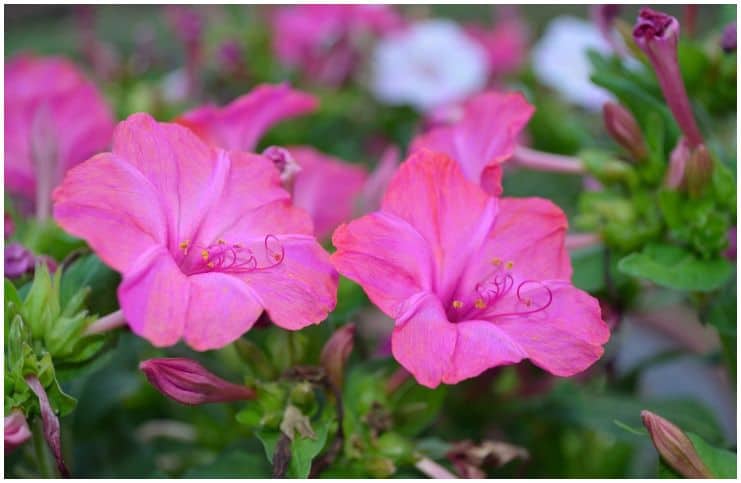Mirabilis Jalapa (Marvel of Peru) Medicinal Uses & Health Benefits:
Mirabilis jalapa, frequently known as the four o’clock flower or the marvel of Peru, belongs to the Nyctaginaceae family. Mirabilis in Latin signifies “wonderful,” and Jalapa is a usual place name in North America and Central.
The four o’clock flower was cultivated by the Aztecs for medicinal and ornamental purposes.
It is also said to have been exported from the Peruvian Andes in 1540. It has become naturalized in many parts of the Southern U.S. and was introduced into Europe by the Spaniards in 1596.
The plant is called four-o’clock because of its flowers, from yellow and white to shades of red and pink, sometimes streaked and mottled. Flowers open in the late afternoon and close by morning.
The plants are erect and spreading, 2-3 ft tall and just as wide. They have many branches and opposite, pointed leaves 2-4 in long.
Chemical Composition
Chemical analysis of the marvel of Peru shows that it is rich in many active compounds, including flavonoids, triterpenes, proteins, steroids, and alkaloids. Of particular interest to researchers is a group of amino acid-based proteins, called mirabilis antiviral proteins (MAPs).
A few components such as stigmasterol, β-sitosterol, ursolic acid, oleanolic acid, brassicasterol, rotenoids (boeravinones C and F, mirabijalone A-D) have been isolated from the aerial parts and roots, respectively. Source
Medicinal Uses of Mirabilis Jalapa (Marvel of Peru)
Regarding its biological activity, the marvel of Peru possesses hypoglycemic, cytotoxic, anti-anti-nociceptive (reduces sensitivity to painful stimuli), hyperlipidemia, anti-histamine, anti-inflammatory, anti-oxidant, anti-spasmodic (meaning that it prevents, relieves, or lowers the incidence of muscle spasms), and antimicrobial (antibacterial, antiviral, and antifungal) properties.
In herbal medicine, parts of the plant may be used as a purgative, diuretic, and for wound healing purposes. The leaf juice is used to treat wounds. The leaves are diuretic, while a decoction is used to treat abscesses. They are used to reduce inflammation.
The root is considered a diuretic as well as an aphrodisiac and purgative. It is used in the treatment of dropsy. A paste of the root is applied as a poultice to treat muscular swellings and scabies.
The juice of the root is used in the treatment of diarrhea, fever, and indigestion. The powdered root, mixed with cornflour (Zea mays) is baked and used in the treatment of menstrual disorders.
Within its natural range in South America, the root of the four o’clock is used medicinally and as a hallucinogen. The flowers are used for making pigments. The flowers actually have no petals – what looks like the corolla is, in fact, the calyx, but only a botanist would appreciate the distinction.
In China, flowers are also used for cosmetic purposes. The root of four o’clock flowers can be consumed as a general body toner and to keep the bowel system and the stomach in good condition.
A decoction of the roots is employed as a purgative. It acts to eliminate freckles and other skin discolorations.
As a decoction recipe, boil one tablespoon of crushed roots in a ½ cup of water for 5 minutes. Its pounded seeds are used in Japan, China, and Malaya for making cosmetic powder.
For candida and viruses generally, a one-half cup of a standard root infusion or 1-2 ml of a 4:1 tincture is taken twice daily. 1 gram of powdered root in capsules or tablets twice daily can be substituted if desired.
Bioremediation
Bioremediation is a process that is used to treat contaminated media, including soil, water, and subsurface material, by altering environmental conditions to degrade the target pollutants and stimulate the growth of microorganisms.
The application of bioremediation technologies is customized to specific site traits, as contaminated soil may be excavated for off- or on-site treatment in place or at surface facilities.
The plant has the potential for the bioremediation of soils polluted with moderate concentrations of heavy metals such as Cd (cadmium).
A 2013 study on the antinociceptive effect of Mirabilis jalapa on acute and chronic pain models in mice confirmed the antinociceptive properties of Eta in clinically relevant pain models.
READ THIS NEXT:
Bellis Perennis (English Daisy) – Side Effects
